What separates us from sinister things, people, or ideas, and how do we know when malevolence lurks nearby? When a protagonist transforms into something grotesque and becomes an object of horror themselves, they cross a threshold and let evil inside. Boundaries of survival spaces are defined and eventually violated in dystopian, zombie, and supernatural horror subgenre films. The concept of liminality combined with foreboding dread and inevitability is hard-wired in the horror genre. Our Outside Your Window series explores themes of boundaries and thresholds in horror films.
Join Richie Jenkins in his analysis of unnatural bodily transformations in horror films.
John Landis’ script for An American Werewolf in London first landed on the desk of the financiers at Polygram Pictures in the late 1970s. It was seen as ‘too frightening to be a comedy and too funny to be a horror film’. The initial idea was conceived on a trip to Yugoslavia earlier that decade (working as an assistant on Brian G. Hutton’s, Kelly’s Heroes), where Landis witnessed a group of Romani burying a man and performing a sacred ritual over his grave. The ceremony it transpired, was performed to prevent the return of the dead man’s spirit. The resulting script secured Landis the $10 million financings he needed to get his lycanthropic horror masterpiece into production, and the film saw release in the summer of 1981.
Two years earlier, Ridley Scott had just released his own tale of homo sapiens’ brittle boned vulnerability to nature’s chaotic order. This came in the terrifying form of a 7-foot tall biomechanical, black-chromatic xenomorph. In both Scott’s Alien, and with Landis’ werewolf film, they took the male of our species, John Hurt’s heavy-smoking, weak, and worn-out Kane, and the loud, cocksure and chipper college grad of David Naughton’s, David, and pronounced with a shrieking, sinew tearing cry that the cinema of body horror, had finally found its groove. On-screen, Scott and Landis introduced us to the worst nightmares of our unrealised imaginations. No longer the blurred images of our mind’s eye, in both Alien and An American Werewolf in London, our flaws and inherent vulnerabilities of both the spirit and the flesh are shown up close and in graphic, bone-cracking detail. This is the pure hell that it is to be endowed with the misery of organic existence [1], while simultaneously having the ability to reflect on that predicament and all the existential dread that this entails. The question begs, why are we not being subjected to, not being awed by, remarkable illustrations of violence that disrupt our passive right to sit safely in our seats, anxiously craving much, much more?
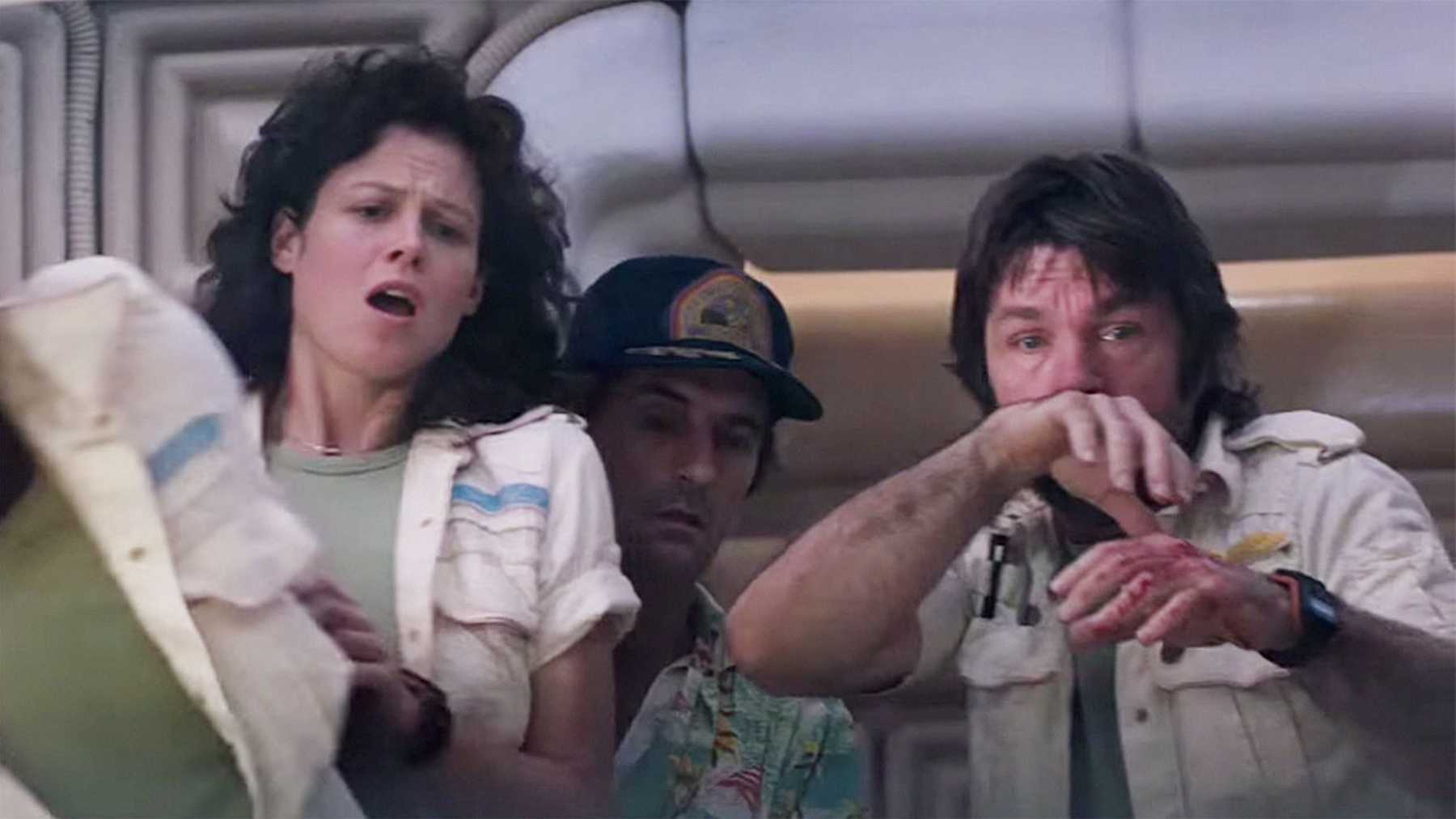
Hell Awaits
As conscious beings, we have this ability to imagine the worst possible scenario. Imagine it, in all its skin-flaying, subjective torment, that sees us stand at the intersection (precipice is possibly a more appropriate analogy here) of both the purity of mind and body and the possibility of an appalling unravelling of all that and the hell that awaits us beyond.
I was at the tender age of 2 when Alien was first released in the US. I didn’t actually come to view the film until sometime in mid-1985 when I was a mere 8 years old. The Betamax tape was still in the top-loader machine from the previous night’s recording when I pushed play and the opening title revealed itself over space. About three-quarters of the way through, I discovered to my absolute horror that only half of the film had made it to cassette, my parents having programmed the machine settings to SP (short play) and not LP (long play). Hence the one-hour thirty-minute tape was just that; one hour thirty. Alien runs at one hour, fifty-seven minutes.
What I am trying to convey here is that the lack of a full film on the tape that day is actually rather irrelevant. I had already witnessed, ingested, and processed more than my innocent and impressionable young mind ever had before, or probably would again, all in just one, unfinished sitting.
My parents were a liberal pair but definitely not the sort to place any old gratuitous dross in front of their children’s eyes. This I was introduced to in abundance throughout my formative years at the birthdays and sleepovers of friends, and a neighbour whose unfettered access to their parents’ film collection was only matched and made possible by the lack of access they had to the parents themselves.
No, there was something in Scott’s Alien, along with a handful of other classic films that came before and a few that would come much later, that my parents thought could be of some intrinsic value to my curious and receptive young mind. My father would routinely call me downstairs late at night whenever a film he considered of historic note was about to air. He thoroughly enjoyed reliving those films with me, and in particular, the scenes that had moved or shocked him in some way or another, through my own wide-eyed incredulity.
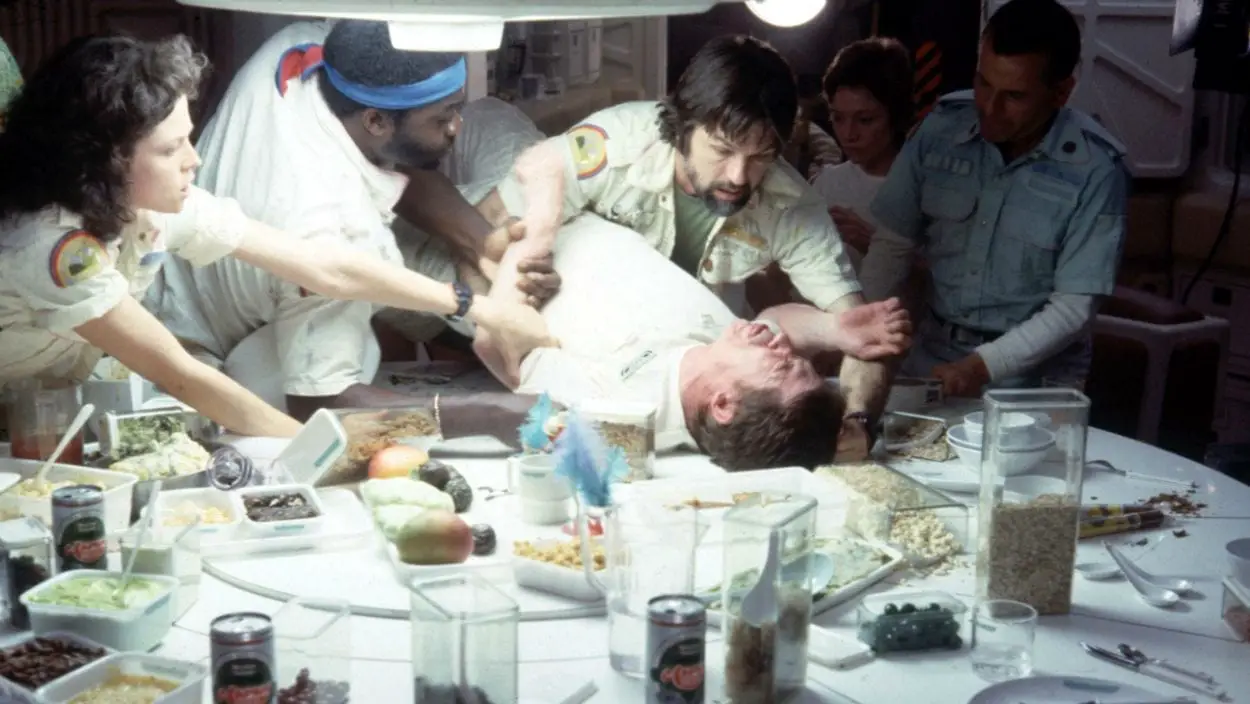
Watching John Hurt’s chest bursting forth that summer’s morning, underage and alone while the rest of the house slept, was like an epiphany to me. As Alexander Huls points out, ‘Horror is often at its most effective when it violently disrupts everyday moments—a shower in Psycho or a midnight skinny dip in Jaws—because they’re the ones we usually think of as moments of safety’. [2] Looking back, it was probably this particular experience that fully realised in me the concept and reality of my own mortality. I could grasp what it meant to have been given life because I could now fully comprehend what it was to have it taken away. In the tragic case of John Hurt’s Kane, it all happens moments after he has woken up from the nightmare that was planet LV-246. Led into a false sense of safety, the filmmaker places the viewer into a fairly ordinary social gathering (albeit in space) over good food and upbeat conversation. Forty seconds in and the scene erupts into what can only be described as an unthinkable nightmare. For the crew, yes, but specifically for Kane, whose life is extinguished in one of the most shocking, surprising, and gut-wrenching scenes of violence to have ever graced the silver screen.
Pain As Pathway To Creation
Death was now very much on my radar. Of course, not in the form of an infant alien thrusting its way through my inner rib cage (although this plagued my imagination for many years to come and still does), but I had been introduced to the very real possibility of violent death—of the extreme pain that would accompany it, the moment before the end of everything, the moment of the end, and then the agonising promise of an infinite nothingness beyond. It is through pain that life is ushered into the world, by birth or mutation, and it is through pain that it is taken away. It is the conduit for growth, gestation or metamorphosis. In film, as in literature or art, it is a key ingredient, the fundamental DNA in the formation of the abomination.

From Man To Monster
Towards the end of the 1980s, I would come to the films of David Cronenberg and Paul Verhoeven—The Fly and Robocop respectively—and much later to Neil Blomkamp’s District 9. Very much like Scott had done before them, these filmmakers framed humanity’s achievements against a dystopian landscape. This is especially evident where it comes to the pursuit and advancement of technology. The protagonists, usually cannon fodder for the sole purpose of scientific endeavour, and ultimately our entertainment, are subjected to whole new levels of cruelty.
However, another film early on in my awakening, a film which pretty much solidified the visceral experience of Alien, was John Landis’s An American Werewolf in London. At the house of a friend, I marvelled at it in amazement, our parents eating prawn cocktails and sipping port in the adjacent room, apparently oblivious to the age range of the children next door. Somehow, Landis managed to rewrite millennia of werewolf mythology with his black comedy and horror. He presented his reluctant changeling as a happy go lucky American tourist who would go through a horrific attack by a beast on the moors. The event would leave his friend (Griffin Dune) dead and himself comatose in hospital. He would now suffer the effects of its curse: visitations from the dead and a once-monthly transformation into a four-legged beast.
Beware The Moon
David’s transformation scene in An American Werewolf in London is nothing short of astonishing, and for so many more reasons than we will be able to consider at length here. The scene set the standard for decades to come and still does today, not just for its use of the most mind-blowing practical effects ever seen on celluloid, but in setting the benchmark for that ultimate of prizes, the total translation of the physical, lived experience in a film, to the real world—a perfect symbiosis between visual and viewer.
So why did this scene work so well and why did it leave such an indelibly huge impression upon the psyche of horror fans and its culture for decades to come? Apart from the sheer amount of work that went into the technical execution of the prosthetics—the legendary Rick Baker and his team toiled tirelessly on this, and won an Oscar for their efforts—the key it would seem, lies in the physical, agonising hell of its unlikely victim. Like Alien before it, the central player is introduced as the everyman, as someone who this should not be happening to, or at least, depending on your sadistic bent, we should not want to happen to. David, thus far in the story, is in every way a likeable (albeit slightly obnoxious) young man. He is a joyously youthful, relatively middle-class suburbanite, and all hopes for his character arc at this point in the story are certainly not for him to be subjected to a body transmogrification so appalling that it can only be described as, in every sense of the words, extreme torture.
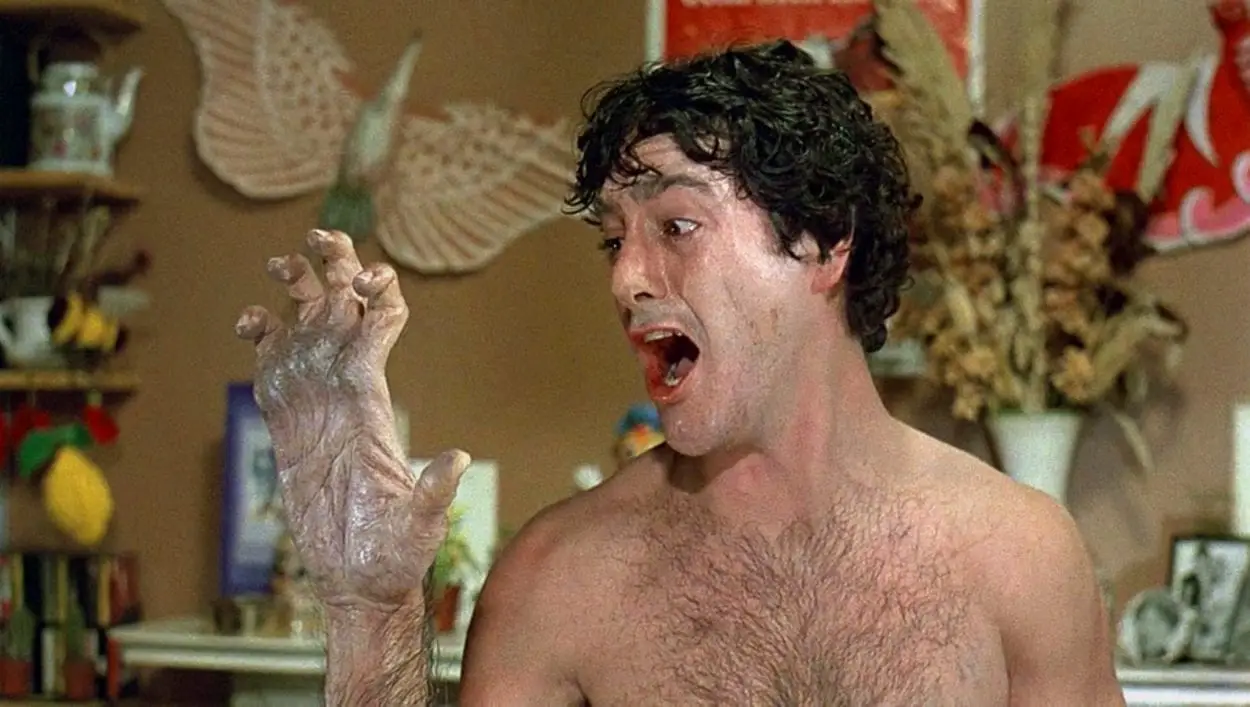
The Transformation
To make things more relatable at this point in the film (and probably just to rub more salt into the proverbial wound), he has just fallen in love with his nurse Alex (a gloriously English and precisely cast, Jenny Agutter) and has also moved in with her. Things seem to be ticking along nicely for David until along pops his dead friend Jack who once again warns of the terrible truth of what is about to happen to him, and all the others that will suffer as consequence. To put it simply, he must take his own life. Still, naturally upset by this encounter, David fails to heed his friend’s ominous warning. That evening, after Alex leaves for a night shift at the hospital, David begins to potter about the apartment. In a scene reminiscent of and recognised by many a bored youth, David watches TV, checks the fridge for food (discovers yet again that he is not hungry), and paces back and forth between the kitchen and living room areas of the apartment until. He eventually settles back into an armchair to read a book.
Seeing the film upon its release in 1981, what follows must have been a revelation. Screaming in agony and launching himself from the chair and onto his knees, David rips the t-shirt from his torso, screaming as if to a higher presence, ‘Jesus Christ, oh God, I’m burning up!” He then proceeds to frantically remove his jeans and underwear, after which he turns to the camera to witness the first of his extremities (his hand) enter the transformation stage.
The change itself is one of abject horror and pain. Not only does David have to mentally process this really quite unique experience, but he also must suffer every bone snap, muscle tear, and limb growth as a fully sentient being before the wolf is fully realised. Hence, any existential woes that he may be having at this point are probably not front and centre in his concern. From hands to feet, to the calcium popping growth of the spine and upper back, the transition lets loose across his young and slender frame. Hair growth accelerates from every follicle and his incisors are pointed and sharp. After David lets out another cry for help, half-human, half-wolf in its anguish, perhaps the most disturbing part of the transition unfolds. David rolls over onto his back and looks down in terror at his now useless human body. Mid-morphing and panicked, he is laid out on the carpet like an anvil-flattened Wile E. Coyote. Back on all fours again, he lets out one last human-like scream before his face elongates into the snout of the wolf. His eyes open, flash yellow and alert, and the scream becomes a blood-curdling roar. The conversion to creature is complete.
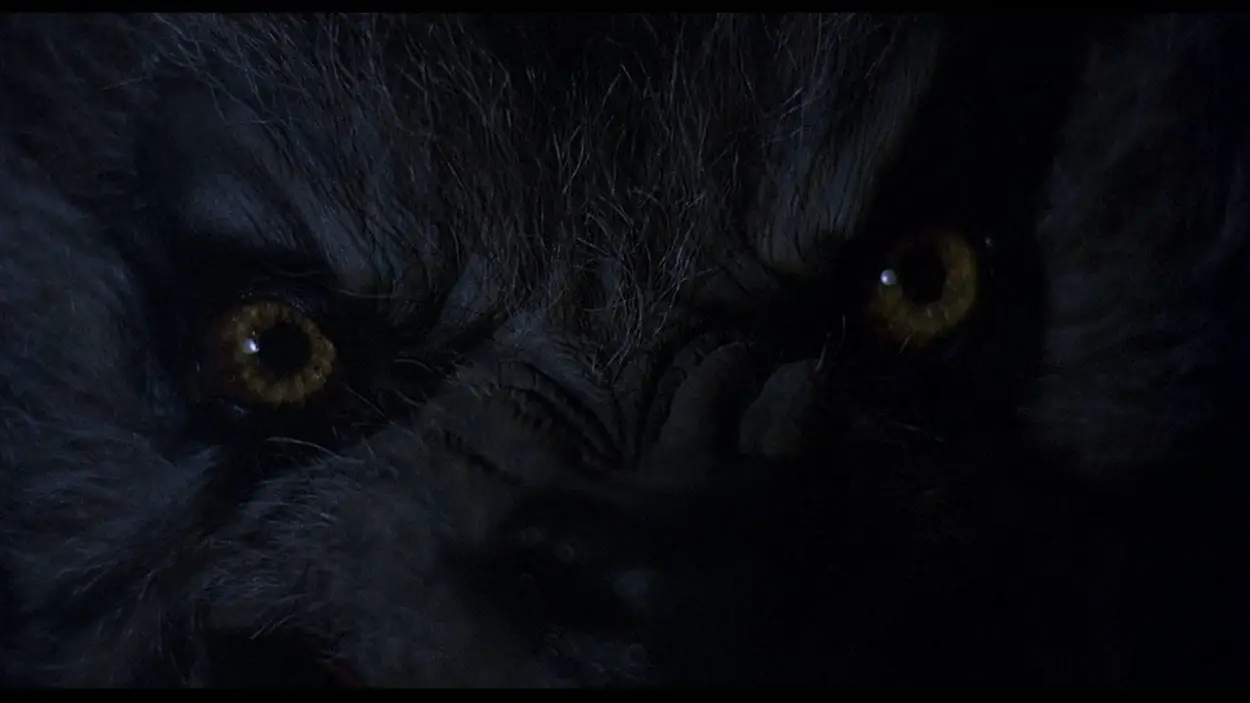
Going Forward
Now laced with early day CGI and all the worldly possibilities of what this can manifest on screen, we need now more than ever to look back at the great directors and films of real-world, practical scene composition and continue to marvel at and learn from their ingenuity and technical expertise. Cinema must at least try to create more great scenes like the chest-burster and werewolf transformation. However, there needs to be a much deeper understanding of what is at stake in moments like these, and from a technical point of view, how these jaw-dropping moments are brought to life. The use of practical effects of times past, although at times clunky, were fully and brutally immersive, placing the viewer at the heart of the action. These events would usually play out in real-time, on camera and in the location they were being shot: you only have to do a little online reading to discover how Ridley Scott fully immersed his cast into the dinner table scene of Alien; those reactions are completely genuine. As a viewer, you are first and foremost a witness. You are in the room, so to speak. You are part and parcel of the narrative.
Another area of focus is how the modern spectacle film continues to place the spectacular over the story and the emotional connection of the action. Huge budgets and a panic-inducing sensitivity to audience and fan expectation has dampened a lot of the deeper creativity and the human connection that truly brings a scene of violence and utter despair to life. When money offers the world, and fan expectation just a template for another unexceptional film, then a scene’s raison d’etre, its purpose, disappears. As an audience, we each bring our own lived experience to a film, and for filmmakers the world over to forget this is to miss a very big trick. It doesn’t just do a disservice to the audience, but to the industry of filmmaking as a whole. Am I alone in wanting to feel like this again?
[1]. Film, Horror, and the Body Fantastic,Linda Bradley, 1985

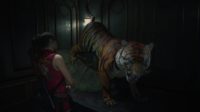
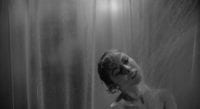
Completely with you on that Carla. If only it would be used to to aid what can be created on camera. There are a few exceptions admittedly but all in all it’s too early days for CGI to be carrying the whole load on its own. Maybe it just needs to go through these early day teething problems to finally get it working. It’s nearly there, just not quite.
No you are not alone in this, There’s just to much CGI now days and to me it cheapens the movie
Thanks so much Christian! I completely agree. If I feel it, then I believe it.
Thanks Christian! Yes I completely agree. When it happens in film and it works, oh my does it work. Make me feel it and I will believe it. Then I am yours.
Nicely put Richie, I know exactly what you mean about missing those moments in film, theatre can sometimes come close in giving you that emotional hit, but rarely, if ever has that same magic that occurs when it works that way in film.